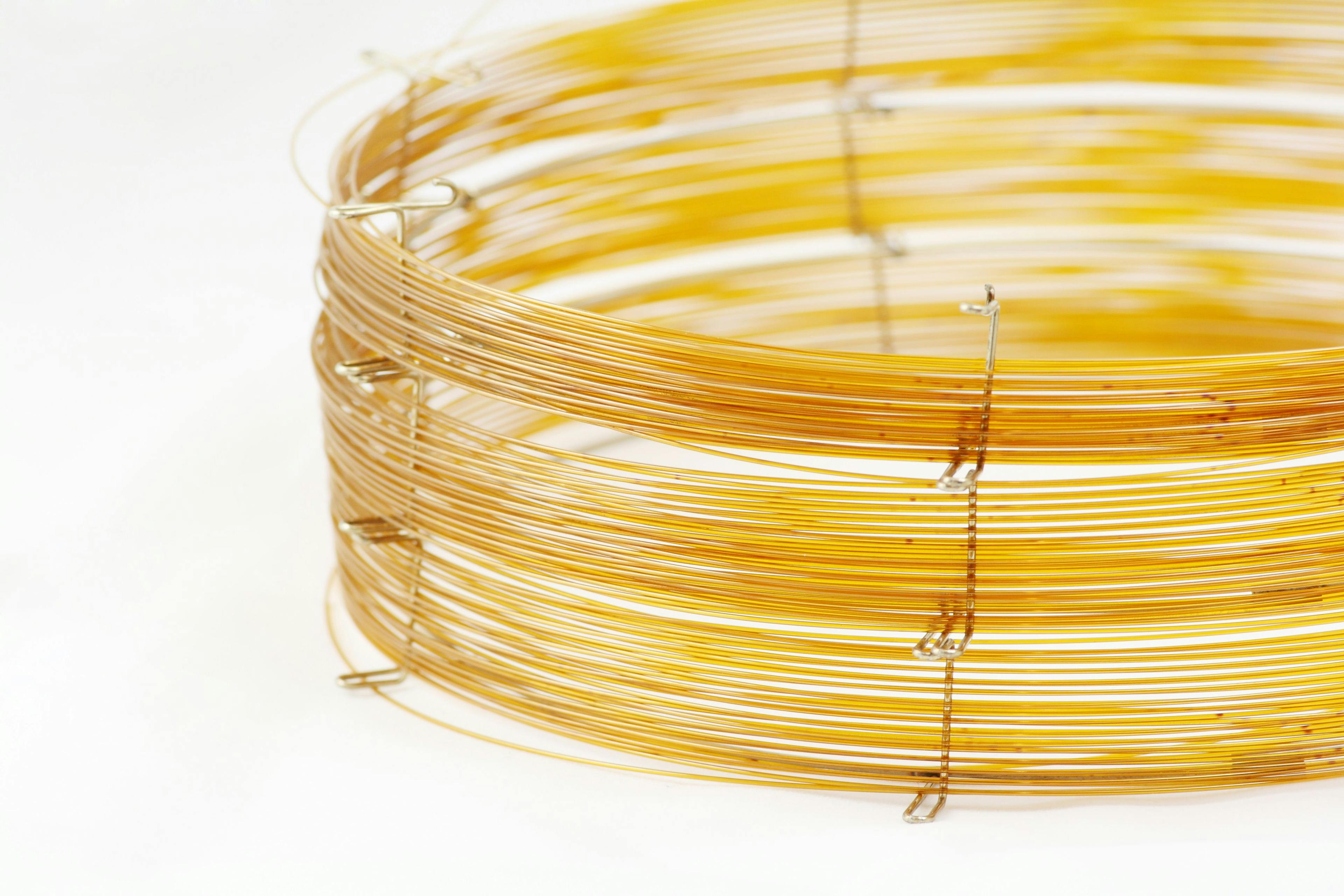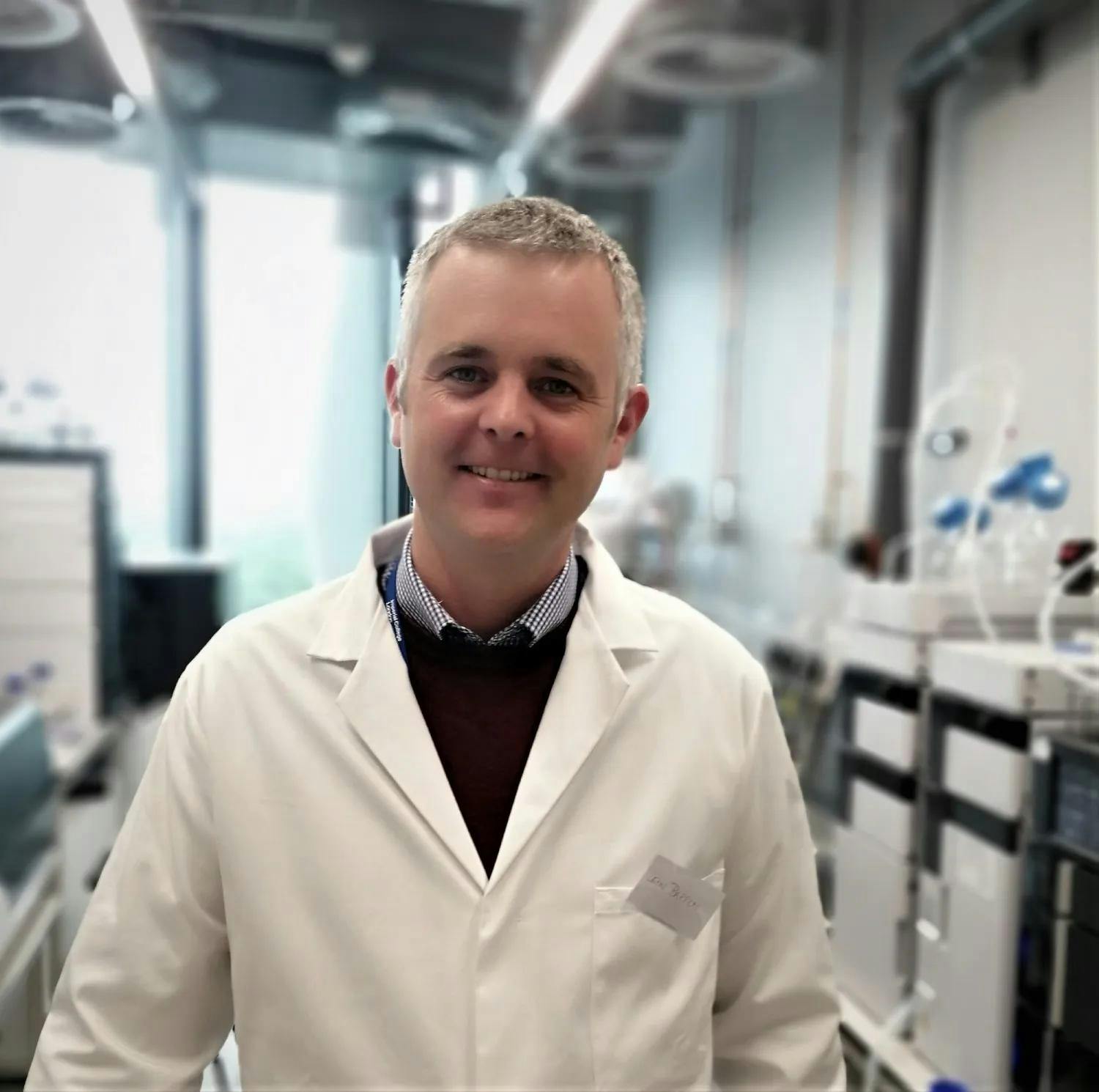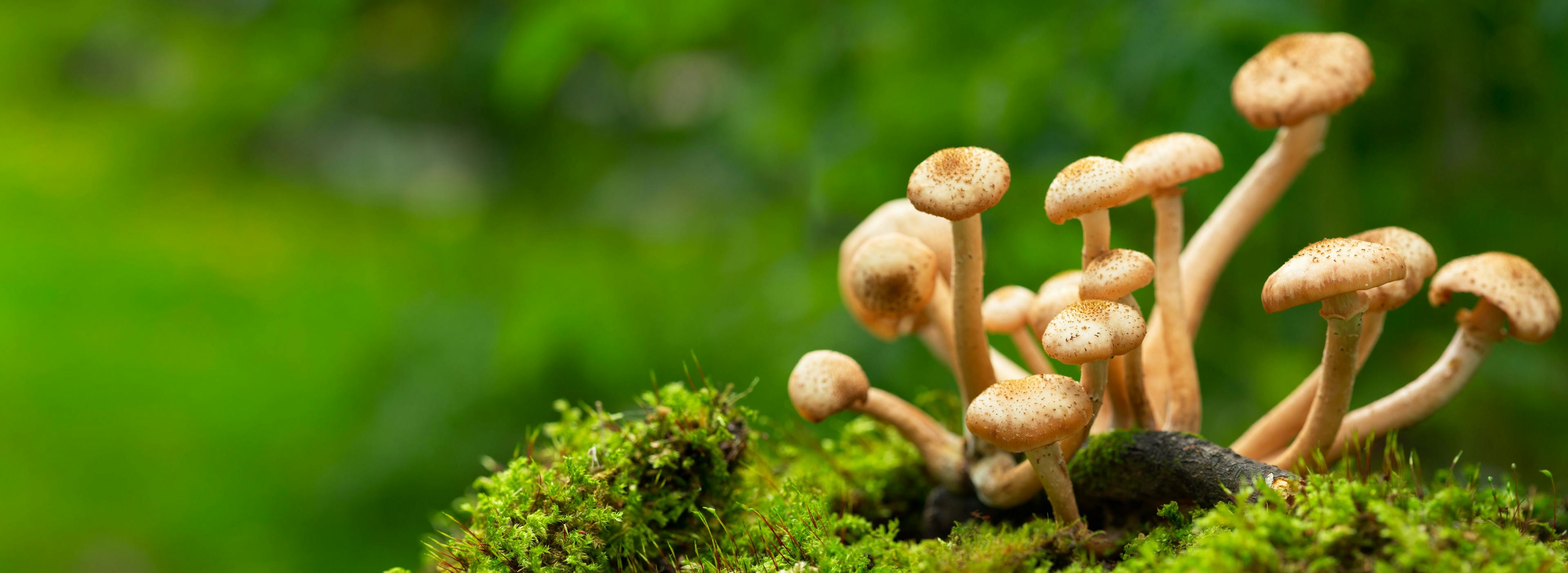Validation of an Aqueous Normal Phase Chromatography Method for the Analysis of Ergothioneine in Commercial Mushrooms
Ergothioneine (EGT) is a naturally occurring food-derived antioxidant found in commercially cultivated mushrooms. EGT is being investigated for health benefits because its therapeutic potential has been demonstrated through neuroprotective capabilities in rat pheochromocytoma cells (1). Although this amino acid is strongly hydrophilic, it is easily absorbed through the digestion process and distributed to various organs (2). As the exact physiological effects are still being determined, this reinforces the importance of identification and quantification of this potentially therapeutic dietary supplement. However, it appears that the main benefit of EGT is as an anti-oxidant and a chelation agent for divalent metal ions. EGT is a hydrophilic zwitterion compound and not optimally retained in reversed-phase liquid chromatography (RPLC) analysis without the use of ionpairing reagents or additional sample derivatization steps. At the time of this study, a method employing the use of a hydrophilic-interaction chromatography (HILIC) retention mechanism required a minimum of 30-min run times, not including equilibration (3). In addition, the sample preparation procedure is fairly complex, thus making the total analysis less than desirable.
Silica hydride columns were tested in an aqueous normal phase (ANP) approach to ascertain if a faster and robust method could be achieved. The use of silica hydride-based stationary phases offers an improved alternative approach to polar compound analysis (4,5). The ANP mode retains polar compounds in similar mobile phase conditions as HILIC, but differs greatly in the retention mechanism while providing more favorable conditions; that is, faster column equilibration time, a reduced concentration of buffers or complex additives, and no requirement of derivatization steps to retain polar compounds. The mechanism of retention for polar compounds on silica hydride stationary phases was not understood until recently because the surface is hydrophobic, yet strong retention of hydrophilic analytes was observed for a broad range of compounds in the ANP mode. The retention mechanism was determined in a few studies, and it is based on the auto-dissociation of water that leads to hydroxyl ions prevalent on the surface, providing silica hydride an overall negative charge (6–9). This is much different than the mechanism in HILIC, where there is a hydration shell layer on the surface to maintain a two-layer (water layer/bulk mobile phase) distribution of the analytes. It was the purpose of this study to utilize the capabilities of silica hydridebased stationary phases to develop a robust quantitative method to identify and quantitate EGT from sample matrices. The EGT ANP method reported has a run time of less than 15 min, with no additional equilibrium necessary. The mobile phase is a simple gradient using deionized (DI) water:acetonitrile with 0.1% formic acid, and it can easily be transferred to LC–MS.
Materials and Methods
HPLC Analysis
The columns used in this study were the Cogent Bidentate C18, the Cogent Phenyl, and the Cogent Diamond Hydride. The dimensions of the columns were 100 x 4.6 mm. All columns were obtained from Microsolv Technology Corporation. The HPLC system used was an Agilent 1200 Series LC system with a degasser, binary pump, diode array detector, thermostated autosampler, and column oven. UV detection at 254 nm was used at a flow rate of 1 mL/min with a DI water/acetonitrile/0.1% formic acid mobile phase and an ANP gradient. The filters (syringe filters, 25 mm, Nylon, 0.45 µm pore size) used for sample preparation were from Microsolv Technology Corporation.
Chemicals
Ergothioneine standard, acetonitrile, formic acid and HPLC-Grade water were purchased from Sigma Aldrich. Ethanol, denatured (5% IPA, 5% n-propyl acetate) was purchased from Oakwood Chemical.
Sample Preparation
- Samples of mushrooms (A. White Button; B. Shiitake; and C. Portobello) were purchased in a local supermarket. The samples were cleaned, dried and sliced. Then, 25.0 g of each mushroom sample was pulverized using a small blender, and 20.0 g of pulverized mushroom samples were dispersed in 20.0 mL of ethanol and sonicated for 30 min. The insoluble materials were filtered out using 0.45 µm nylon membrane filters, and the filtrate was used for HPLC analysis.
- One milliliter of each sample was evaporated to dryness and the residue was then resuspended in 0.50 mL of ethanol. Samples were filtered using 0.45 µm nylon membrane filters and the filtrate was used for HPLC analysis.
- Spiked samples were prepared by adding ergothioneine standard to pulverized, unfiltered samples (target concentration was 0.05 mg/mL). The spiked samples were then completed, as in the first bullet point, and analyzed. Comparisons of the peak areas were made with samples to which no standard was added and with a known standard concentration.
- Stock solution of the ergothioneine was prepared at a concentration of 1 mg/mL and dilutions were made in the range
- of 0.01–0.1 mg/mL in ethanol.
Each standard was injected six times, and mushroom samples (original, evaporated, and spiked) were injected six times.
The structure of EGT is shown in Figure 1.
Figure 1: Ergothioneine structure
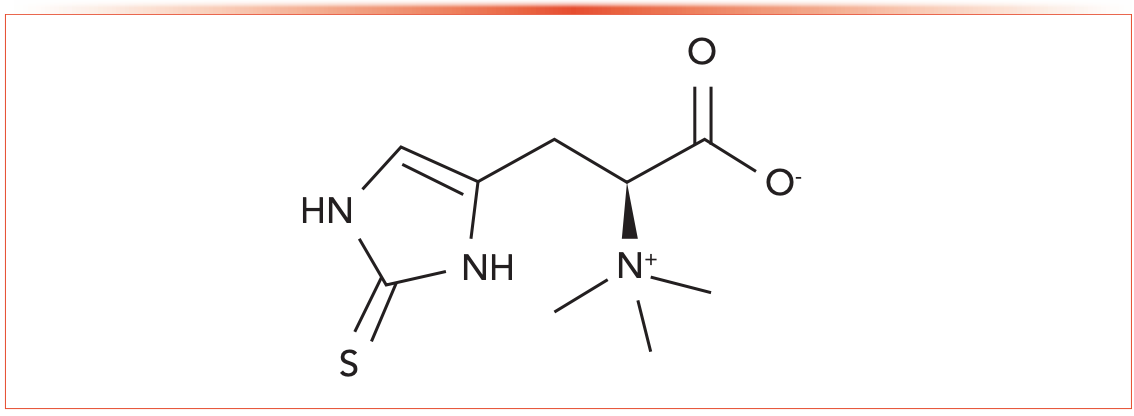
Results
In this study, several stationary phases were evaluated, and, in the end, the best results were achieved when the Cogent Diamond Hydride (DH) column was used. When either the Cogent Bidentate C18 or the Cogent Phenyl columns were used, no significant retention for EGT was achieved under reversed-phase (RP) conditions, and when ANP conditions were used, the peak shape for EGT was not satisfactory (data not shown). Figure 2a shows the results for the EGT standard on the Bidentate C18 where very small retention is observed, even when using a mobile phase with a high water content (90%). Figure 2b shows the results of analyzing a mushroom extract where it can be seen that EGT is not adequately separated from some of the other components in the sample. These results are not surprising since both the columns tested are mainly used in RP (7) and ergothioneine is not suitable for analysis under these conditions. The next choice was the DH column in the ANP mode that is more suitable for polar compounds, such as EGT. Preliminary runs showed significant retention for EGT under ANP conditions.
Figure 2: Analysis of ergothioneine (EGT) during method development. (a) EGT standard on C18 column, 90% deionized water:0.1% formic acid, and (b) analysis of shiitake mushroom extract on C18 column, 90% deionized water:0.1% formic acid, and (c) analysis of mushroom sample using water extraction procedure, optimized method on diamond hydride (DH) with aqueous normal phase (ANP) gradient, and (d) analysis of mushroom sample using ethanol extraction procedure optimized method on DH (ANP gradient). Note: x-axis label is Time (min), and y-axis label is Absorbance (mAU).
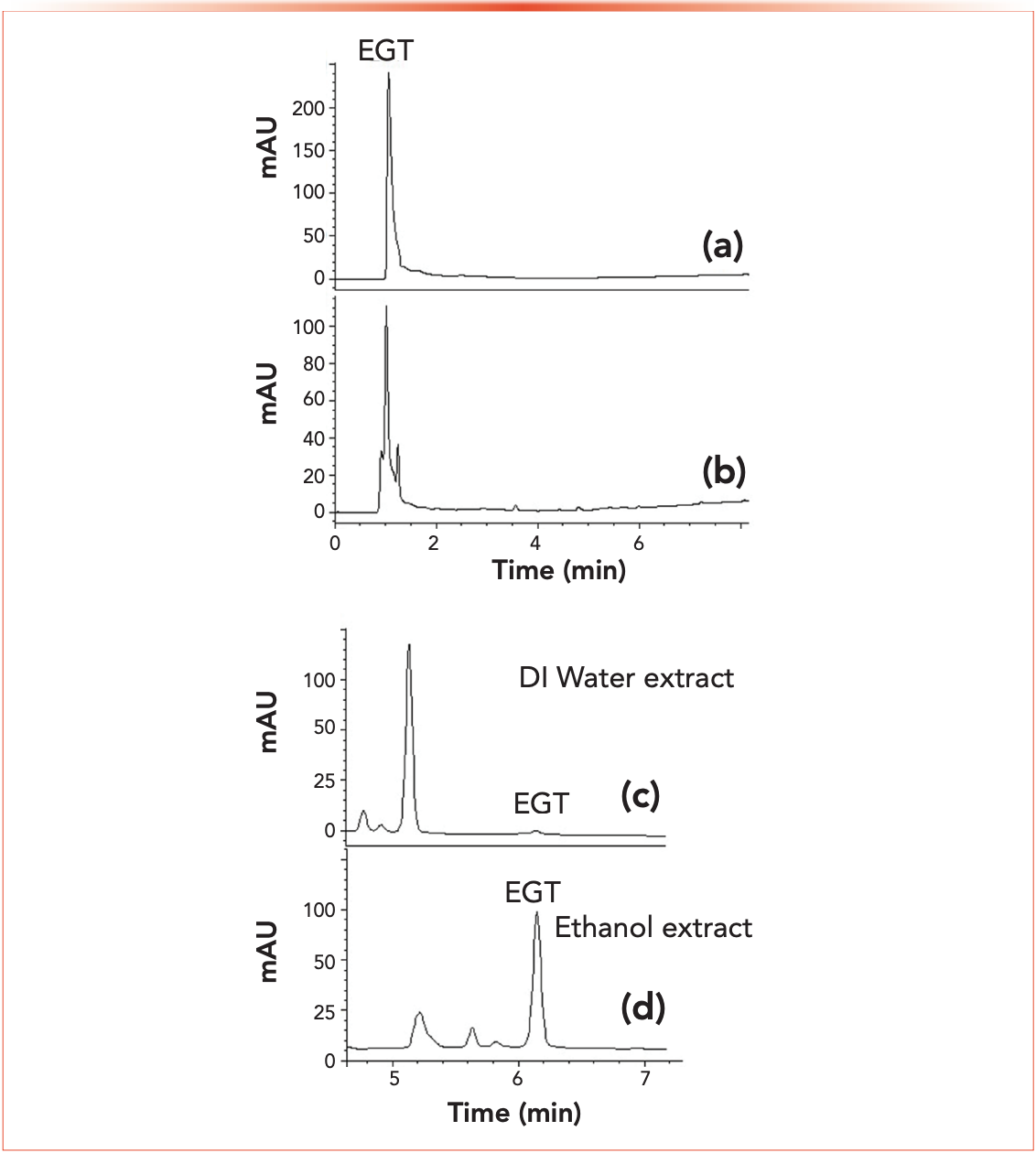
After the selection of the DH column, isocratic conditions compared to gradient ones were investigated. When isocratic conditions were used, adequate retention time for ergothioneine was obtained and peak symmetry was 0.98. However, when longer retention of EGT was required to achieve separation from other components in mushroom extracts, the EGT peak shape was less than satisfactory, so a simple ANP gradient was used instead.
Different solvents (methanol, acetone, acetonitrile) in deionized water, as well as different additives (acetic acid, formic acid, ammonium acetate, ammonium formate), were chosen for the mobile phase optimization process. The optimum conditions for the retention of ergothioneine and separation of this compound in mushroom extracts was obtained by using deionized water with 0.1% formic acid as solvent A and acetonitrile with 0.1% formic acid as solvent B.
Column temperature is known to affect the retention time, peak shape and resolution. The effect of column temperature was changed in the range of 25–35 °C. There was no apparent change in the separation parameters when the temperature was changed in the studied range. However, to assure good repeatability of the retention times, the temperature of the column was kept constant at 30 °C.
Extraction was evaluated using two different solvents: water and ethanol. Figure 2c shows the result of the water extraction, and Figure 2d is the chromatogram obtained for the ethanol extraction. Because of the greater signal provided by the ethanol procedure, it was selected for use in the optimized protocol. Mushroom extract samples prepared with and without evaporation and reconstitution were compared, and it was determined that samples analyzed without evaporation and reconstitution showed better recovery. It was decided to use samples which were not evaporated.
It was determined that there were no interference peaks at the retention time for the standard ergothioneine in mushroom extracts. Figure 3 shows the ANP chromatogram of EGT in a mushroom extract demonstrating that the developed method is suitable for the analysis.
Figure 3: Aqueous normal phase (ANP) chromatogram of EGT in spiked portobello mushroom extract using optimized method conditions. Column: CDH, Solvent A: deionized water with 0.1% formic acid; Solvent B: acetonitrile with 0.1% formic acid. The gradient: 0 min, 90% B; 6 min, 60% B; 7 min, 60% B; 8 min, 50%; 9 min, 50% B; 10 min, 90% B; 12 min, 90% B. Note: x-axis label is Time (min), and y-axis label is Absorbance (mAU).
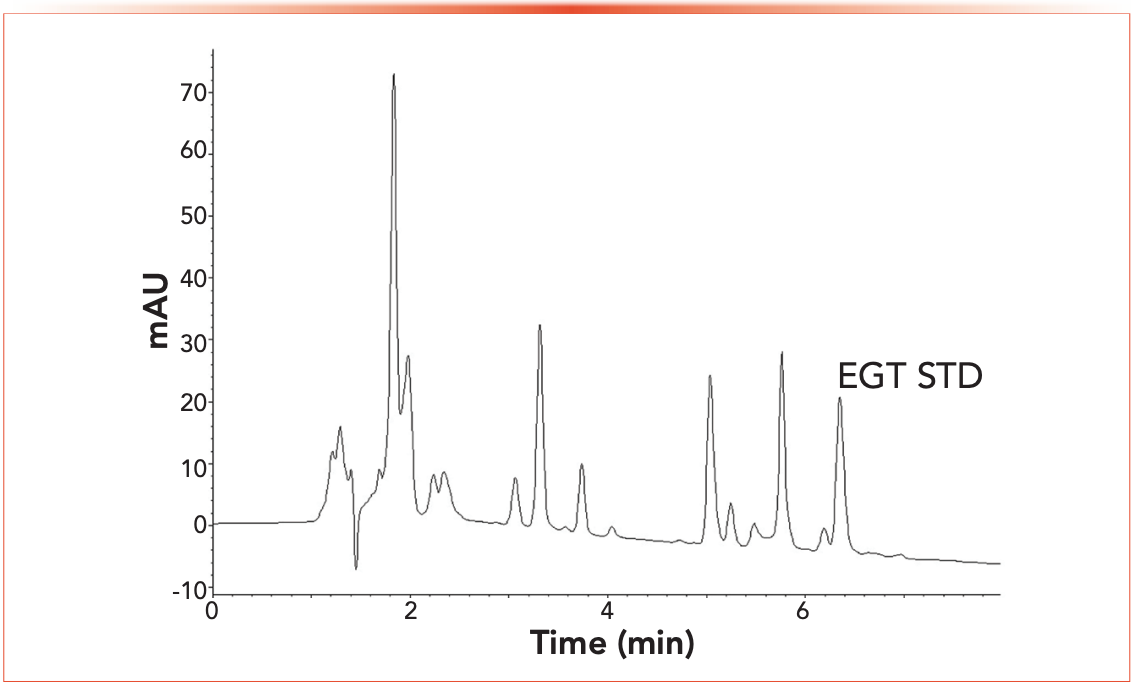
Method Conditions
A Cogent Diamond Hydride column was used to test this method. Solvent A contained DI water with 0.1% formic acid, and solvent B contained acetonitrile with 0.1% formic acid. The gradient times were as follows: 0 min, 90% B; 6 min, 60% B; 7 min, 60% B; 8–9 min, 50% B; 10 min, 90% B; and 12 min, 90% B.
Method Validation
System Suitability
Tests were performed to ensure that the HPLC system used for the analysis could provide quality data based on USP requirements. Several parameters were calculated to determine system suitability. The EGT limit of quantitation standard of 0.005 mg/mL (LOQ) and the bracketing working standard of 0.05 mg/mL were injected in each HPLC run. The results are listed in Table I.
Table I: Results for system suitability

Method Robustness
Variation of critical parameters, such as percent (%) of formic acid (±0.05%) in the mobile phase, flow rate (±0.05 mL/min) and the column temperature (±5 °C) were done for the analysis of EGT. The results are presented in Table II. The parameters were assessed, and the results indicate that only a small degree of variation for theoretical plates, tailing factors and retention times were observed when column temperature and flow rate was deliberately changed. The method was robust with respect to the parameters changed.
Table II: Results for the determination of method robustness.
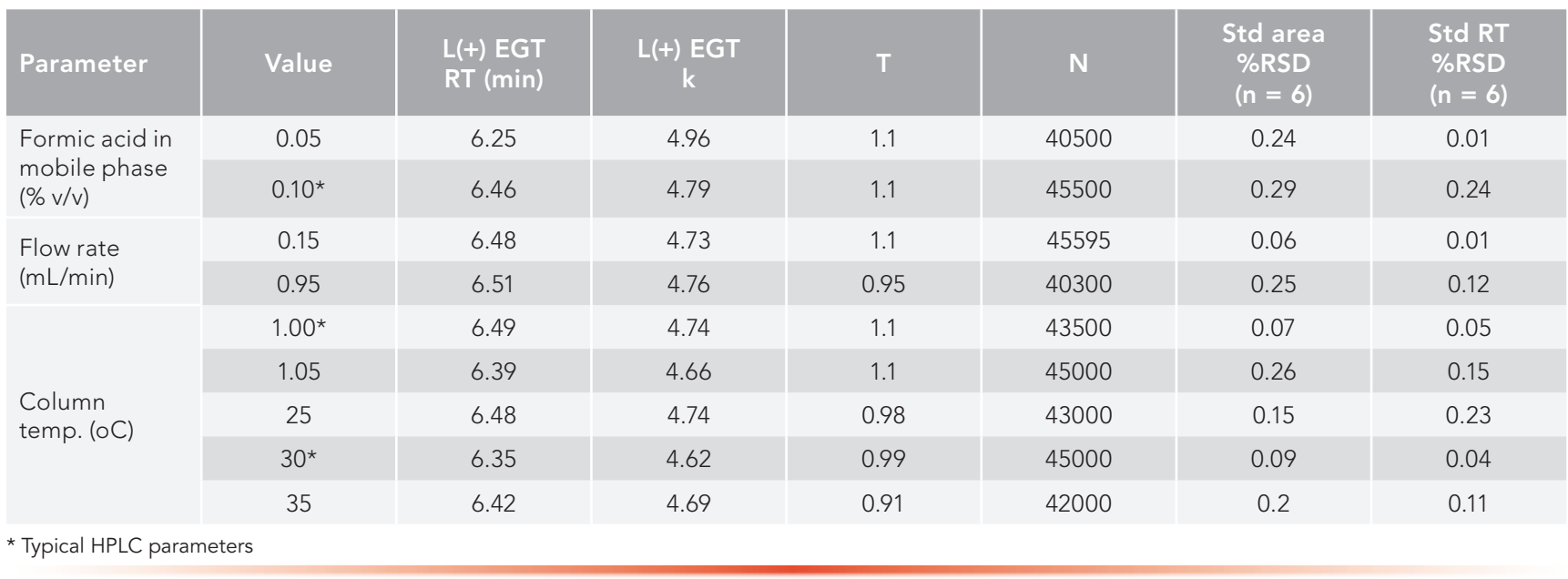
Calibration Curves
A series of standard solutions over the range of 0.01–0.1 mg/mL in ethanol were used to determine the linear range of the analysis using the external standard method. Calibration curves were generated by plotting peak areas vs. concentration. A regression line with the formula y = 401.6x - 60.53, where x is the concentration of EGT, and y is the corresponding standard peak area. The correlation coefficient (R2) was 0.99999.
LOD, LOQ Determination
The EGT standard was further diluted with ethanol to determine the LOD and LOQ. Assuming a 95% confidence level and calculations of LOD = [3.3*(sigma/s)] and LOQ = [10*(sigma/s)], the LOD was determined to be 0.0025 mg/mL and LOQ was 0.005 mg/mL.
Recovery
Standard addition recovery experiments were performed using spiked mushroom extract samples. The recoveries of EGT standard from the extracts ranged from 96.5–100.3%, which indicated that the method is highly accurate and reliable.
Repeatability
The EGT mushroom extracts were analyzed using six replicate injections over 3 days. Figure 4 shows the chromatogram of shiitake mushrooms. A selectivity factor α value of 1.16 from sample matrixes of shiitake ergothioneine with a %RSD of less than 0.5 for 6 standard injections over several days were obtained. Relative Standard Deviation of retention times of EGT in these injections were below 1%, proving the precision of the system.
Figure 4: Shiitake extract sample, overlay of injections from 3 d. Note: x-axis label is Time (min), and y-axis label is Absorbance (mAU).

The EGT concentration in mushroom extract was determined to be white button (0.045 mg/g), shiitake (0.067 mg/g), and portobello (0.005 mg/g). The results are comparable to other published determinations (9), except for portobello mushroom extract. The difference in the concentration of EGT between the determination in this report and the one by N.J. Dubost and others (10) is because the values reported in the cited manuscript are for freeze-dried mushroom samples, and the values here are for nontreated samples. The very low amount of EGT in the portobello mushroom extract was detected because there was a very small peak at the retention time for EGT. However, there was a substantial peak about 1 min earlier. It is possible that another form of EGT, D-ergothioneine, was present in portobello mushrooms, and that it was not separated from L-ergothioneine in the other investigation. The Cogent Diamond Hydride column has been shown to be able to separate D and L forms of ascorbic acid (9). LC–MS studies would need to be conducted to support this statement.
Conclusions
A simple, reliable, robust and accurate ANP method for the quantitative determination of EGT in extracts of commercial mushrooms was developed using a DH stationary phase. The EGT was adequately separated from the sample matrix components in the mushroom extracts. The method was proved rugged over a concentration range of 0.01 to 0.1 mg/mL for ergothioneine. The excellent retention, selectivity, and resolution for EGT demonstrates that ANP is a good method of choice for the analysis of EGT samples containing complex ingredients. The simplicity and low-cost sample preparation process make the method useful for routine analyses in EGT mushroom extracts and other sources of this compound (nutrients). The fast equilibration (3 min) and run time of less than fifteen minutes prove to be a “greener” approach than current HILIC HPLC methodologies that require a minimum 30-min run time, not including typical long equilibrations and difficulties with reproducibility.
It was discovered shiitake mushrooms contained the greatest natural amount of EGT, whereas the portobello mushrooms contained the least amount of L (+) EGT.
However, it is possible that D (+) EGT is present in portobello mushrooms.
Acknowledgments
The authors would like to thank Microsolv Technology Corporation for donation of the HPLC columns used in the analysis.
References
(1) Jang, J, H.; Aruoma, O. I.; Jen, L. S.; Chung, H. Y.; Surh, Y. J. Ergothioneine Rescues PC12 Cells from Beta-amyloid-induced Apoptotic Death. Free Radic. Biol. Med. 2004, 36, 288–299.
(2) Ishimoto, T.; Kato, Y. Ergothioneine in the Brain. FEBS Lett. 2022, 596, 1290–1298. DOI: 10.1002/1873-3468.14271
(3) Liu, Q.; Zhang, W.; Wang, H.; Li, Y.; Liu, W.; Wang, Q.; Liu, D.; Chen, N.; Jiang, W. Validation of a HILIC Method for the Analysis of Ergothioneine in Fermentation Broth. J. Chromatogr. Sc. 2016, 54, 934–938. DOI: 10.1093/chromsci/bmw023
(4) Pesek, J. J.; Matyska, M. T. Silica Hydride: A Separation Material Every Analyst Should Know About. Molecules 2021, 26, 7505. DOI: 10.3390/molecules26247505
(5) Sandoval, J. E.; Pesek, J. J. Synthesis and Characterization of a Hydride Modified Porous Silica Material as an Intermediate in the Preparation of Chemically Bonded Chromatographic Stationary Phases. Anal. Chem. 1989, 61, 2067–2075. DOI: 10.1021/ac00193a013
(6) Kulsing, C.; Yang, Y.; Munera, C.; Tse, C.; Matyska, M. T.; Pesek, J. J.; Boysen, R. I.; Hearn, M. T. W. Correlations Between the Zeta Potentials of Silica Hydride-based Stationary Phases, Analyte Retention Behaviour and Their Ionic Interaction Descriptors. Anal. Chim. Acta. 2014, 817, 48–60. DOI: 10.1016/j.aca.2014.01.054
(7) Pesek, J. J.; Matyska, M. T.; Larrabee, S. HPLC Retention Behavior on Hydride-based Stationary Phases. J. Sep. Sci. 2007, 30, 637–647. DOI: 10.1002/jssc.200600414
(8) Pesek, J. J.; Matyska. M. T. The Development of Silica Hydride Stationary Phases for High Performance Liquid Chromatography from Conception to Commercialization. Separations 2019, 6, 27– 41.
(9) Microsolv Technology Corporation Chrom Resource Center. D and L Ascorbic acid Separation Analyzed with HPLC- AppNote. Microsolv 2022. https://kb.mtc-usa.com/article/d-and-l-ascorbic-acid-separation-analyzed-by-hplc-appnote/46/ (accessed 2023-03-07)
(10) Dubost, N. J.; Beelman, R. B.; Peterson, D.; Royse, D. Identification and Quantification of Ergothioneine in Cultivated Mushrooms by Liquid Chromatography. Int. J. Med. Mushrooms 2006, 8, 215–222.
About the Authors
Joseph J. Pesek and Maria T. Matyska are with the Department of Chemistry at San Jose State University, in San Jose, Califrornia. Tanya Hiltz is with MicroSolv Technology Corporation in Leland, North Carolina. Gary Takeoka is with the U.S. Department of Agriculture, in Berkeley, California. Direct correspondence to: joseph.pesek@sjsu.edu
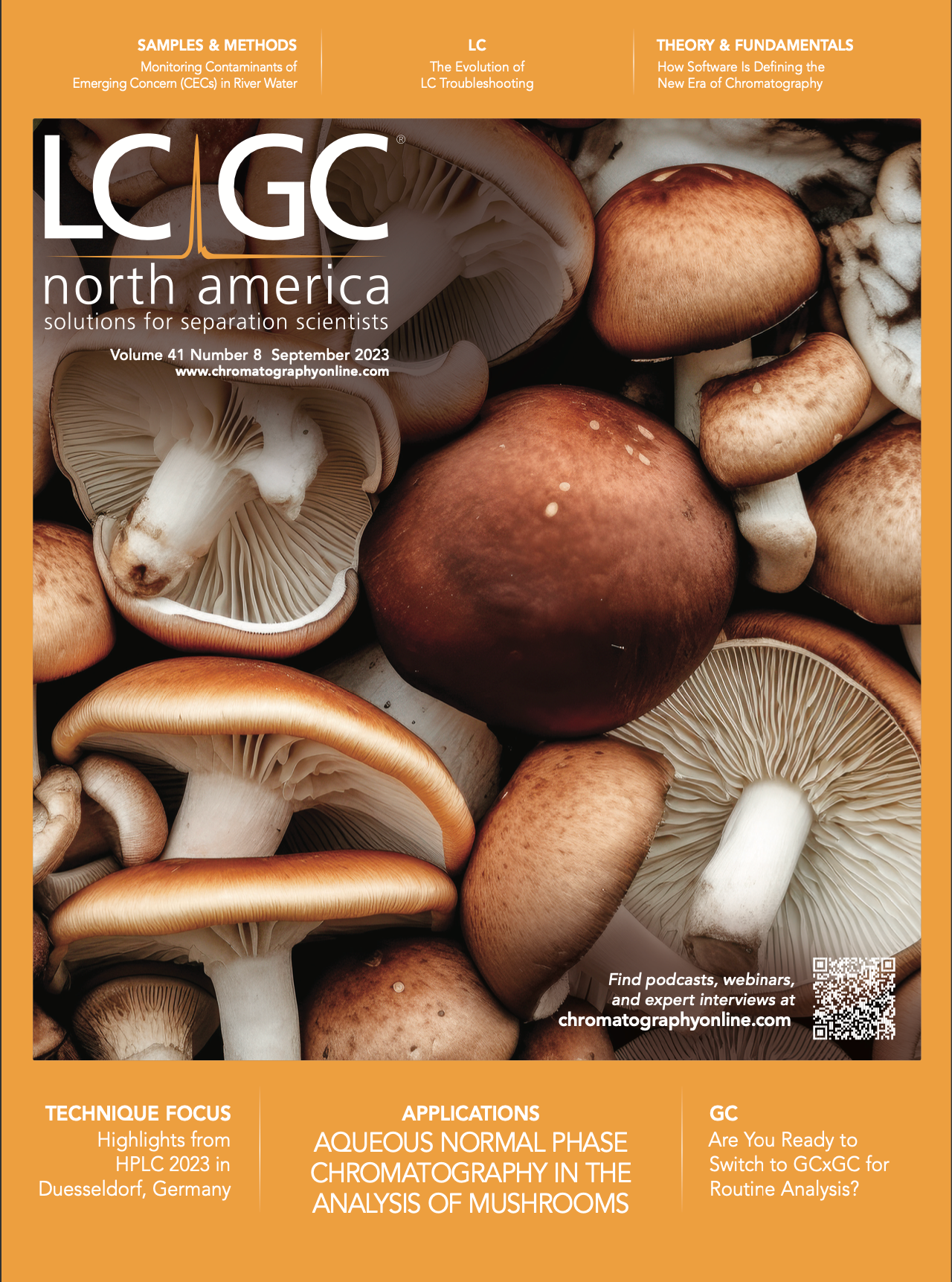
New Study Reviews Chromatography Methods for Flavonoid Analysis
April 21st 2025Flavonoids are widely used metabolites that carry out various functions in different industries, such as food and cosmetics. Detecting, separating, and quantifying them in fruit species can be a complicated process.
Extracting Estrogenic Hormones Using Rotating Disk and Modified Clays
April 14th 2025University of Caldas and University of Chile researchers extracted estrogenic hormones from wastewater samples using rotating disk sorption extraction. After extraction, the concentrated analytes were measured using liquid chromatography coupled with photodiode array detection (HPLC-PDA).



